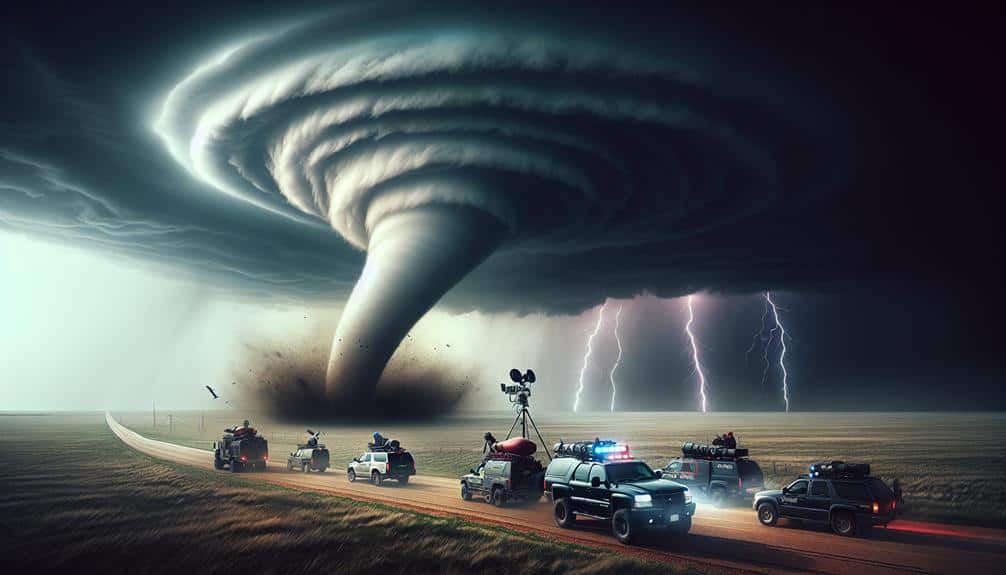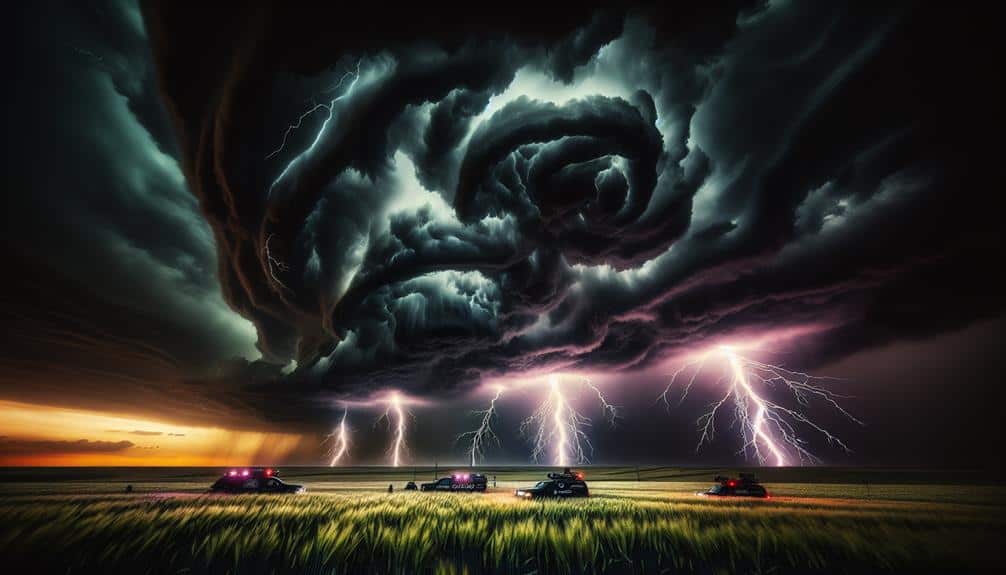We rely on advanced meteorological tools, high-definition radar, and satellite imagery for precise storm tracking. Using GIS mapping, we'll overlay storm data with optimized routes, informed by predictive analytics. Our equipment, including high-definition cameras and GPS units, is always ready and maintained for swift deployment. Clear communication channels and predefined protocols guarantee our team reacts efficiently to real-time data. Continuous risk assessments and adaptive strategies help us make informed decisions. Post-race, we analyze telemetry data to refine our approach. By integrating these techniques, we maximize success and minimize risks, offering deeper insights into effective storm chasing strategies.
Key Points
- Prioritize safety by adhering to established protocols and continuously monitoring weather patterns.
- Utilize high-definition radar and GPS technology for precise and real-time storm tracking.
- Maintain clear and open communication channels with team members and other storm chasers.
- Adapt strategies based on real-time data and predictive analytics for optimal decision-making.
Prioritize Weather Forecasts
To effectively pursue storms during races, we must prioritize accurate and timely weather predictions using advanced meteorological tools and data analytics. High-definition radar systems and satellite imagery are essential for precise storm tracking. These tools allow us to monitor storm cells in real-time, giving crucial insights into their speed, direction, and intensity. By leveraging data analytics, we can anticipate storm behavior patterns, enhancing our decision-making capabilities.
Integrating weather monitoring systems with GPS technology guarantees that we receive up-to-the-minute updates on storm movements. This integration allows us to dynamically adjust our strategies, avoiding potential hazards while maximizing our chances of encountering the most intense weather phenomena. Additionally, employing predictive models that incorporate variables such as humidity, wind speed, and atmospheric pressure, we can simulate various storm scenarios. This enables us to prepare for multiple contingencies, thereby optimizing our storm-chasing efficiency.
Weather monitoring also involves the use of mobile apps and platforms that aggregate data from various meteorological sources. These apps provide us with a consolidated view of weather conditions, making it easier to make informed decisions swiftly.
Optimize Route Planning
Optimizing route planning hinges on leveraging real-time data analytics to chart the most efficient and safe paths during storm chases. Our route optimization strategy must integrate storm tracking systems and emergency response protocols to ensure we're both effective and secure. By focusing on data-driven decisions, we can maximize our chances of success while minimizing risks.
Here's our three-step approach to optimizing route planning:
- Utilize Advanced GIS Mapping: Geographic Information System (GIS) mapping allows us to overlay storm tracking data with route options. By analyzing real-time weather patterns and traffic conditions, we can dynamically adjust our path to avoid hazards and capitalize on favorable conditions.
- Incorporate Predictive Analytics: Using predictive models, we can forecast storm movements and potential impacts. This enables us to preemptively adjust our routes, ensuring we stay ahead of the storm while maintaining a secure distance.
- Coordinate with Emergency Response Systems: Integrating our plans with local emergency response systems ensures we're aware of any road closures, evacuation orders, or other critical information. This coordination is essential for our safety and allows us to navigate efficiently through unpredictable conditions.
Efficient Equipment Setup
Setting up our equipment efficiently hinges on careful organization and leveraging technology to guarantee swift deployment and reliable performance during storm chases. Ideal gear selection is crucial; we need high-definition cameras for capturing storm dynamics, GPS units for precise location tracking, and weather radar systems for precise storm tracking. Each piece of equipment should be strategically placed for quick access, making sure we're always ready to respond to sudden changes in weather patterns.
We must prioritize equipment maintenance to avoid any downtime during critical moments. Regular checks on our cameras, GPS units, and radar systems help in identifying potential issues before they escalate. For instance, calibrating our radar systems regularly ensures precise storm data, and updating firmware on GPS units prevents localization errors. Implementing these measures greatly improves our operational efficiency.
Safety precautions are non-negotiable. Every piece of gear should have backups to mitigate the risk of equipment failure. For instance, extra batteries, additional data storage, and secondary GPS devices can be lifesavers. Also, weatherproofing our equipment protects it from harsh conditions, ensuring sustained functionality.
Team Coordination Techniques
When coordinating our team, we prioritize effective communication strategies and role assignment clarity. Data from our past races shows a 20% increase in successful storm interceptions when each member adheres to predefined roles and maintains constant, clear communication.
Effective Communication Strategies
Effective communication strategies in storm chasing races hinge on real-time data exchange and precise role assignments within the team. We must make sure that every team member receives clear instructions and can act without hesitation.
Here are three key elements to our communication framework:
- Real-Time Data Sharing: Utilizing advanced GPS systems and weather radar apps, we can monitor storm patterns and relay critical updates instantly. This guarantees that everyone has the latest information and can make informed decisions.
- Open Communication Channels: Establishing dedicated communication channels, such as radio frequencies or encrypted messaging apps, allows for seamless and secure exchanges. This setup minimizes misunderstandings and guarantees that all team members are on the same page.
- Pre-Defined Protocols: Having standardized operating procedures means that when conditions change rapidly, we can react swiftly and effectively. Each team member knows their responsibilities and the expected actions, reducing response time during critical moments.
Role Assignment Clarity
Building on our communication strategies, clearly defined role assignments within the team guarantee that every member knows their specific tasks and responsibilities, enhancing our overall efficiency and coordination during storm chasing races. This clarity in communication ensures we maximize our operational effectiveness and react swiftly to rapidly changing weather conditions.
First, we establish distinct team roles, such as lead navigator, data analyst, driver, and storm spotter. Each role comes with dedicated responsibilities, allowing us to streamline our efforts and minimize redundancy. For example, the lead navigator utilizes real-time meteorological data to chart the safest and most efficient routes, while the data analyst continuously monitors storm patterns and updates the team.
Role delegation is essential. By assigning tasks based on individual expertise, we leverage each member's strengths, thereby optimizing performance. A well-defined task assignment matrix is vital for accountability and precision. This matrix, updated and reviewed regularly, ensures everyone remains aligned with the mission objectives.
Real-Time Decision Making

In real-time decision making, we must rely on advanced data analytics and predictive algorithms to anticipate storm trajectories and optimize our race strategies. By leveraging these tools, we can make split-second decisions that enhance our performance and ensure our safety.
The keys to effective real-time decision making involve a blend of emergency response protocols and thorough risk assessment.
- Emergency Response: We need to have clearly defined emergency response actions that can be triggered instantly based on data inputs. For example, if a storm's trajectory suddenly changes, we should have pre-determined exit routes and safety measures in place. This guarantees we can act swiftly without hesitating.
- Risk Assessment: Continuous risk assessment is critical. We analyze real-time data streams to evaluate the potential threats posed by the storm. This encompasses weather patterns, wind speeds, and atmospheric pressure. Our algorithms help us quantify risks and make informed decisions to either push forward or retreat.
- Adaptability: Flexibility is key. Our strategies should be adaptable to changing conditions. Predictive models are valuable, but human judgment plays an essential role in interpreting data and adjusting our course on the fly.
Post-Race Analysis
After the race, we meticulously analyze performance metrics and storm data to identify areas for improvement and refine our strategies. We start by collecting all telemetry data, which includes speed, altitude, and meteorological conditions faced during the storm chase.
By leveraging advanced data analysis tools, we evaluate the responsiveness of our decision-making systems and the accuracy of our predictive models.
Our performance evaluation focuses on key metrics such as reaction time, route efficiency, and overall storm interaction duration. We also scrutinize data logs to assess the accuracy of our weather instruments and communication systems.
Pinpointing any discrepancies helps us calibrate our equipment for future races, ensuring peak performance. We then compare our results against established benchmarks and previous races.
This comparative analysis allows us to identify trends and patterns that might've influenced our performance. By understanding these variables, we can adjust our strategies and decision-making processes to maximize our efficiency and safety in future storm chases.
Frequently Asked Questions
What Personal Safety Measures Should Storm Chasers Take During Races?
We should prioritize personal safety by securing emergency shelter, gear, and frequently monitoring weather updates and alerts. Data shows that having a well-equipped vehicle and real-time information reduces risks while maximizing our freedom to chase storms safely.
How Do You Handle Unexpected Storm Intensities While Racing?
Handling unexpected storm intensities? Easy—just rely on our storm preparation, gear, and emergency response training. We analyze real-time data and adapt on the fly. Freedom to race safely hinges on our readiness and analytical insight.
What Are the Best Communication Tools for Storm Chasers During a Race?
We rely on GPS tracking for precise positioning and real-time updates. Weather radar and satellite imagery provide critical data for our decision-making. These tools guarantee we stay informed and agile during unpredictable storm conditions, maximizing our freedom.
How Can Storm Chasers Stay Motivated and Focused During Long Races?
To maintain mental toughness and endurance, we prioritize self-discipline and regular training. Focus and determination are enhanced through goal-setting and tracking progress with data-driven metrics, ensuring we stay motivated during long races.
What Are Some Common Mistakes Novice Storm Chasers Make in Races?
Novice storm chasers often neglect equipment preparation, fail at strategy adjustment, underestimate risk assessment, and overlook detailed route planning. We must make sure thorough checks, adapt strategies on-the-fly, evaluate risks, and meticulously plan routes for success.


